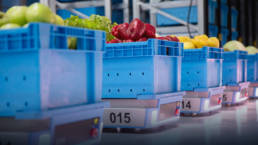ARTICLE
The Picking Series – Store Productivity
Profitability hinges on efficiency. Understanding the store from a fulfillment perspective can help retailers quickly maximize operational outputs at low costs.

Take advantage of your stores and strengthen your bottom line
Grocers must find their path to profitability in the digital age. Most retailers are unsatisfied with their margins, and grocery e-commerce isn’t going anywhere anytime soon; almost 14% of grocery orders were placed online in the first half of 2022, with that number projected to continue growing. Outsourcing the digital channel isn’t the answer – 81% of grocers view 3rd party marketplaces as long-term competitors making it critical that grocers begin building their technical capabilities. Our series begins with an overview of store productivity because leveraging existing assets is crucial to driving efficient and profitable e-commerce fulfillment.
There are several ways to consider involving the store in fulfillment operations. In-store picking can be one of the most cost-effective fulfillment options because it bypasses the multi-million dollar investment required by a stand-alone picking center (e.g. dark store or MFC). Even if grocers choose not to directly pick from their store shelves, existing retail locations are close to customers and can serve a role in order staging and curb-side operations. Retailers must stay conscious of how store fulfillment will impact inventory and staffing demands. Anticipating obstacles will prevent disruptions to existing stocks or procedures, protecting and enhancing the overall customer experience.
Single picking is the most straightforward method to implement. This picking method offers the lowest efficiency and capacity levels, but is perfectly suitable when demand is low and can allow for a higher-touch customer experience. Shorter lead times, lower order volumes, lower basket sizes, or some combination of the three would be suitable for a single-pick fulfillment strategy. Even as retailers move on to more sophisticated operations, single picking can serve as a valuable component of their overall fulfillment mix (for the aforementioned use cases).
Multi-pick becomes the more effective option as order volumes rise. This strategy aggregates and then segments orders, grouping items together so that they can be fulfilled by multiple pickers at once. Order segmentation takes advantage of zoning strategies through planograms and pick path optimization; this tailors picking to individual stores in the most intelligent way. The capacity and efficiency unlocked at this fulfillment level can be used to maximize the potential of in-store picking. By deploying a successful multi-pick strategy some Wynshop customers have been able to rival the productivity levels of dark stores, at a fraction of the cost.
In tandem with an in-store picking strategy, staging environments are a necessary facet of the picking process. Retailers must account for the needs of different item classes (e.g. frozen) before and after order consolidation. Orders that have been picked in separate segments should be labeled appropriately so they can be combined accurately. The logistic pressure created by managing time slots, fragmented orders, and staging requirements is large, and the right technology can make or break backroom operations.
Grocers cannot sacrifice their in-store experience throughout this process. E-Commerce fulfillment is a critically important undertaking, but more than 85% of grocery sales are still done in-store. The key to omni-channel success is cohesion between (and across) the channels. Training staff to pick orders without disrupting shoppers is one step towards that cohesive existence. Another is inventory management: both e-commerce shoppers and in-store shoppers suffer when there are product gaps and outages, and good inventory visibility can prevent any potential issues with service levels.
The competition is fierce, but success is within reach. Retailers shouldn’t leave any value on the table as they move to satisfy their customers and expand operations to the current demand. Our next series topic will expand on the relationship between e-commerce fulfillment and product availability!
The Picking Series #2

Product Availability
High product availability drives brand loyalty and sales. Grocers should seize the opportunity offered by e-commerce technology to track and improve availability across all channels.
The Picking Series #3

The Future of Store Picking and the Fulfillment Mix
The grocery landscape is exploding with investment and opportunity. Grocery retailers who keep an eye on coming trends can make informed and confident decisions moving forward.


